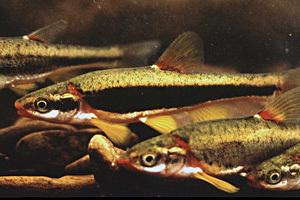by the Center for Biological Diversity

Blackside dace photo by Richard G. Biggins, USFWS.
LEXINGTON, Ky.— A federally protected fish called the blackside dace was among numerous fish killed in Kentucky’s Acorn Fork creek by a small spill of hydraulic fracking fluid that caused the fish to develop liver and spleen damage and gill lesions, according to a federal study released this week. The report documenting the 2007 incident, which comes a month after reports that a natural gas company repeatedly dumped polluted fracking water directly into the Big Sandy River, highlights the threat to wildlife and water quality posed by even small amounts of the toxic chemicals used to extract natural gas from fracking wells.
“These two sickening incidents in Kentucky make clear the growing threat that fracking poses to endangered species, public health and drinking water supplies across much of the country,” said Tierra Curry, a scientist at the Center for Biological Diversity.
The study released on Wednesday by the U.S. Fish and Wildlife Service and the U.S. Geological Survey shows that leaks of toxic fracking fluid caused the major fish kill in Acorn Fork by increasing the creek’s acidity and conductivity, a measure of heavy metal pollution. Numerous species were killed, including the threatened blackside dace, a small colorful fish that lives only in Appalachia in Kentucky, Tennessee and Virginia. The agencies reported in the study that even small-scale spills can be a threat to endangered species.
In July a Kentucky television station reported that a gas worker came to them to report that he had been ordered to dump fracking fluid directly into the Big Sandy River, which winds between Kentucky and West Virginia and supports a number of imperiled aquatic species. The man said he came forward because he felt guilty about dumping the water into the beloved waterway. He said he reported the incident to the television station after he reported it to state agencies who failed to take action. The state issued violation notices, but has yet to approve enforcement action or assess penalties for the incident.
Fracking fluid threatens freshwater species and drinking water supplies because of both the large quantity of water needed to inject into wells and the toxic substances used. Massive quantities of water are withdrawn from creeks and lakes to inject into wells, drying up habitats and decreasing water supplies. Fracking fluids can contaminate both groundwater and surface water because the waste that returns to the surface is acidic and can be contaminated with both heavy metals and radioactive particles.
Many waterways in Appalachia are already heavily polluted by metals and acidity from coal mining operations. More than 20 peer-reviewed scientific studies have been published linking public-health problems to pollution from mountaintop-removal coal mining, including increased rates of cancer and birth defects.
“Replacing coal mining with fracking is a jump from the frying pan into the fire. We’ve simply got to figure out how to move away from these dirty fossil fuels that are threatening the lives of people and endangered species,” said Curry, a native of eastern Kentucky.

